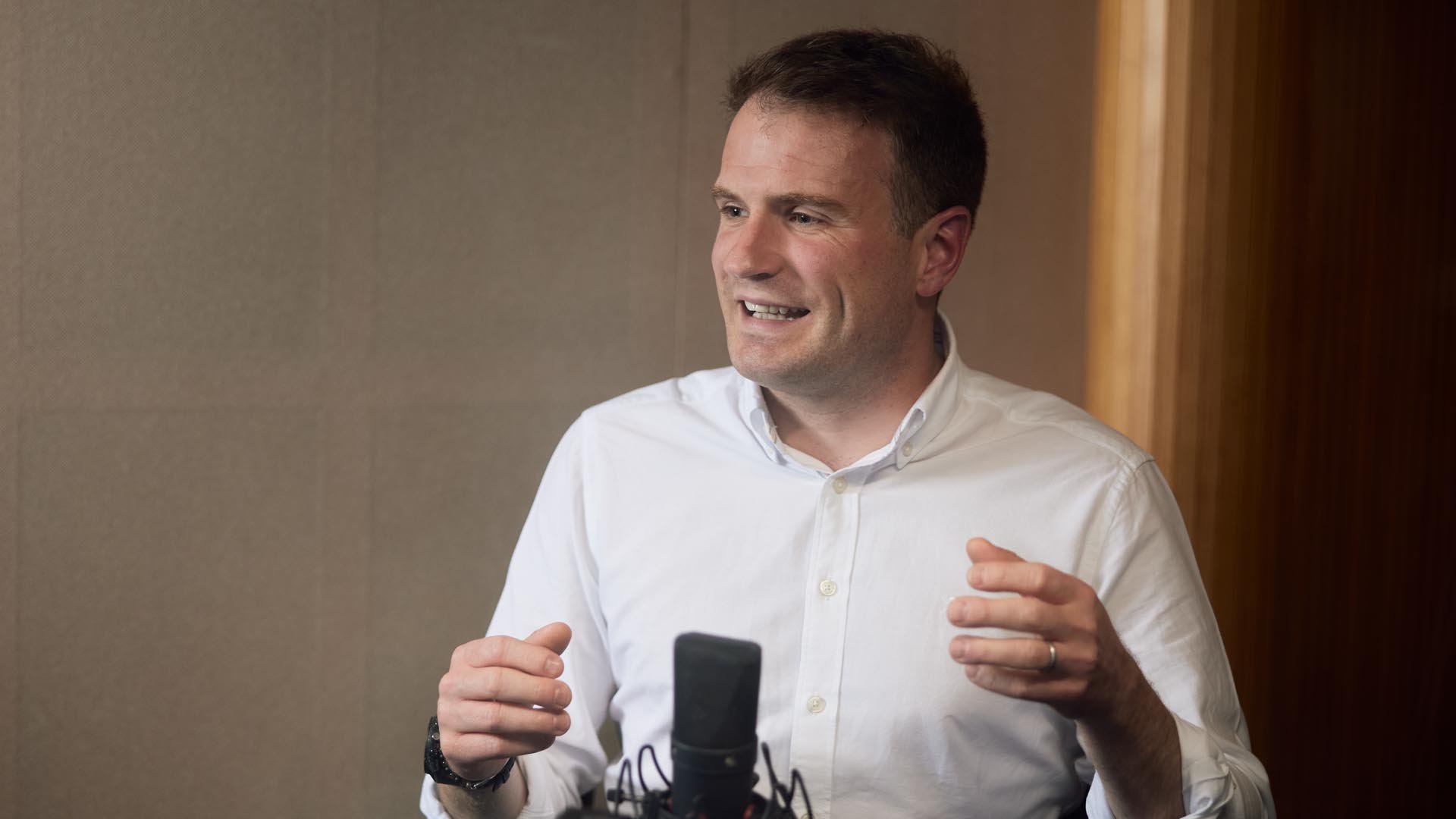Key points:
- Our 75/25 approach reflects the Fund’s objective to produce long-term capital growth
- To us, asset allocation is about backing the stock picking enthusiasm of our experienced managers
- Fund positioning reflects our view that the long-term opportunity for resilient firms remains exciting

All investment strategies have the potential for profit and loss, capital is at risk. Past performance is not a guide to future returns.
Lucy Haddow, Managed Fund Specialist, discusses asset allocation within the Baillie Gifford Managed Fund, why our approach differs from others in the industry, and what is driving current positioning.
Q1. What is the Managed Fund’s strategic asset allocation and how is it decided?
It’s probably worth starting with an explanation of what we mean by ‘strategic asset allocation’. Essentially, this is our starting point for how we split the Managed Fund up between the different types of assets available to us. On that basis, the strategic asset allocation is 75 per cent equities, 20 per cent bonds and 5 per cent cash. We say 'strategic' as we can deviate from this starting position, which we'll explain below.
Many in the industry may be familiar with a 50/50 or a 60/40 approach, so our 75/25 starting point is a little different. That’s very much driven by the Fund’s long-term objective: to achieve capital growth over rolling five-year periods.
To achieve that, we want the vast majority of the Fund’s assets invested in equities because that’s the asset class that’s going to drive returns, that’s going to drive growth over periods of five to ten years and beyond.
At the same time, the Managed Fund adopts a balanced approach and so we want to have a meaningful exposure, typically around 25 per cent, to bonds and cash to provide diversification. Bonds of course playing a dual role, as they are also there to add to returns.
Within the 75 per cent allocated to equities, we break that down into four equal allocations to the UK, the US, Europe, and a combination of Developed Asia and emerging markets (EM).
As a starting point, the bond allocation is broadly half in global government bonds, mainly developed markets plus a little EM, and half in global credit – corporate debt.
It’s worth noting that the Fund sits within the Investment Association’s Mixed Investment 40–85% Shares share sector. Our 75 per cent strategic weight in equities clearly puts us at the higher end of equity allocations and that means that the performance of our Managed Fund may diverge considerably from other funds in the peer group. But we believe that differentiation is extremely important, crucial for us to be able to deliver differentiated returns over the long term.
I don’t want to ignore cash. It obviously won’t deliver the highest returns over the long run, but it has a role in the Fund to provide some optionality. We’ve been taking advantage of volatility in the markets over the past year or so, putting some of that cash to work as we have found attractive opportunities in both equities and bonds.
Q2. Who has responsibility for asset allocation and how often do they meet?
The Managed Policy-Setting Group, or PSG, is responsible for setting asset allocation for the Managed Fund. I chair the Group, which comprises individuals with real breadth and depth of experience.
From the investment floor, you have the two managers of the Fund. Iain McCombie has been involved with the Managed Fund since the year 2000 and Steven Hay’s involvement goes back to 2012. In a former life, Steven spent several years at the Bank of England, producing analysis for the Monetary Policy Committee and managing foreign currency reserves. They are joined on the PSG by Andrew Stobart. Andrew – who joined Baillie Gifford in 1994 – manages the EM equity portion of the Managed Fund.
We then add in a member of Baillie Gifford’s separate Multi Asset Team, as they bring in a completely different perspective. That’s because the typical focus of the Policy-Setting Group is on bottom-up asset allocation, by which I mean enthusiasm for individual stocks and bonds, opportunities to deliver long-term growth. By contrast, our Multi Asset Team take a more top-down, macroeconomic, approach. Getting that sort of input and challenge is really helpful to our thinking.
We meet up quarterly, albeit we can meet up in between times should that be required. In fact, all of the members of the Policy-Setting Group are based in our Edinburgh office, so it’s very easy to have a quick discussion when we need to.

Q3. How do you decide how much to allocate to each area?
As I alluded to earlier, asset allocation is about following where the stock picking takes us. So, from the starting point of the strategic weights described above, we can tilt the portfolio one way or the other, backing the enthusiasm of the managers and allocating capital to those regions or assets where the most ideas are coming through at a single point in time.
Each quarter, ahead of our PSG, the equity and bond managers meet separately. They each collate a submission for the main meeting that expresses a view as to how enthusiastic or otherwise they are and setting out where they’re finding new ideas. What would they do if the PSG increased their weighting? Would it be invested in new buys or would it be a pro rata addition to existing holdings?
Those submissions are then a really important part of the PSG’s discussion, although the Group also thinks about the bigger picture. In my mind, it’s about taking a step back – from our strategic 75/25 starting point how much do we want in each pot? It’s important that we go back to that strategic asset allocation each quarter. We’re not just making changes based on what went before as you could quickly find yourself drifting away from where you’d really want to be with a blank sheet of paper.
As I said the main focus is on the bottom-up rather than the top-down. In terms of limits, we work within a range of our strategic 75/25 asset allocation plus or minus 10 per cent.
Q4. What happens if everybody wants to increase their allocation?
In the eight years or so that I’ve been involved with the Policy-Setting Group, I can’t remember an instance when everybody wanted to increase their allocation so it must be a pretty rare occurrence!
However, how would we deal with that situation if it ever arose? We’d use cash. If the equity and bond managers were all very enthusiastic at the same time then we’d bring down the cash balance of the Fund to allow for increased allocations across the portfolio.
If we were in that situation, a robust challenge from the Policy-Setting Group would be crucial, an independent review of the enthusiasm levels of different managers. On the whole, we trust the expertise and knowledge of our regional equity and bond experts. We want to back them, but if we were to see repeated requests for more money in their area, then it is important that we challenge that. As I say, each quarter we’re going back to our strategic starting point, rather than necessarily just building on allocations that have been made in the past. That’s a helpful discipline.
Q5. What are your current allocations and why?
So, at present we are 78 per cent in equities, 19.5 per cent in bonds, and 2.5 per cent in cash. So overweight in equities – that might surprise some people given the volatility over recent months. Why is that? In equities, it’s simply reflecting the enthusiasm coming through from our UK, Emerging Markets and Developed Asia managers.
Now, it's obviously a pretty tough environment to do business at present – high inflation, rising interest rates. The next few years will be difficult for even the best businesses in the world. But the analysis of our teams, which looks at near-term resilience and the long-term opportunity available to companies, means there is a degree of optimism and enthusiasm coming from the equity managers that we want to back.
In fact, when you combine the fact that forecast profits have already been cut due to the difficult backdrop with the fact that higher interest rates have seen share price valuations pull back somewhat, then we think it’s a pretty attractive picture if, and this is important, if it’s viewed with a long-term mindset. That’s what’s feeding into that overweight allocation to equities.
Within bonds, we’re broadly in line with our strategic allocation of 20 per cent. I think what’s probably most interesting is that if you were to turn back the clock to December 2021, we had about 17 per cent in bonds but we made incremental additions over 2022.
Again, we are seeing more attractive valuations in that area than we’ve seen in a long time. We’ve moved from a point where 18 trillion dollars of global government bonds were trading with a negative yield to the situation in the past 12 months or so, where there were no government bonds with a negative yield. There are risks that central banks hold rates higher for longer, but yields are a lot more attractive than they have been for years. That means our bond assets can both deliver returns in their own right and provide better balance to the rest of the Fund.
On top of that, there are some fantastic opportunities in corporate bonds, particularly investment grade. We’re seeing yields we haven’t seen on offer since the global financial crisis.
Bringing all that together, the tone of our last PSG meeting was one of cautious optimism, certainly not blind optimism. There are challenges ahead, but matched by some exceptional opportunities. All the way from the high tech businesses like AutoStore which helps firms organise and automate their logistics, to the much more familiar like Greggs the bakers here in the UK. We believe the Fund is in a really good place for the next five years and beyond.
Important information and risk factors
The views expressed in this article should not be considered as advice or a recommendation to buy, sell or hold a particular investment. They reflect opinion and should not be taken as statements of fact nor should any reliance be placed on them when making investment decisions.
This communication was produced and approved in April 2023 and has not been updated subsequently. It represents views held at the time of writing and may not reflect current thinking.
Custody of assets, particularly in emerging markets, involves a risk of loss if a custodian becomes insolvent or breaches duties of care.
The Fund invests in emerging markets where difficulties in dealing, settlement and custody could arise, resulting in a negative impact on the value of your investment.
Bonds issued by companies and governments may be adversely affected by changes in interest rates, expectations of inflation and a decline in the creditworthiness of the bond issuer. The issuers of bonds in which the Fund invests, particularly in emerging markets, may not be able to pay the bond income as promised or could fail to repay the capital amount.
The Fund’s share price can be volatile due to movements in the prices of the underlying holdings and the basis on which the Fund is priced.
Any stock examples used in this article are not intended to represent recommendations to buy or sell, neither is it implied that they will prove profitable in the future. It is not known whether they will feature in any future portfolio produced by us. Any individual examples will represent only a small part of the overall portfolio and are inserted purely to help illustrate our investment style.
This article contains information on investments which does not constitute independent research. Accordingly, it is not subject to the protections afforded to independent research and Baillie Gifford and its staff may have dealt in the investments concerned.
All information is sourced from Baillie Gifford & Co and is current unless otherwise stated. The images used in this article are for illustrative purposes only.
Baillie Gifford & Co and Baillie Gifford & Co Limited are authorised and regulated by the Financial Conduct Authority (FCA). Baillie Gifford & Co Limited is an Authorised Corporate Director of OEICs.
| 2019 | 2020 | 2021 | 2022 | 2023 | |
| Baillie Gifford Managed Fund B Acc | 8.4 | 0.2 | 46.4 | -8.2 | -8.5 |
| IA Mixed Investments 40%–85% Shares Sector Median | 4.5 | -7.8 | 26.3 | 5.4 | -4.3 |
Source: FE, Revolution, net of fees, total return in sterling terms.
The manager believes an appropriate comparison for this Fund is the Investment Association Mixed Investment 40–85% Shares median given the investment policy of the Fund and the approach taken by the manager when investing.
Past performance is not a guide to future returns.
Ref: 40703 10020092




